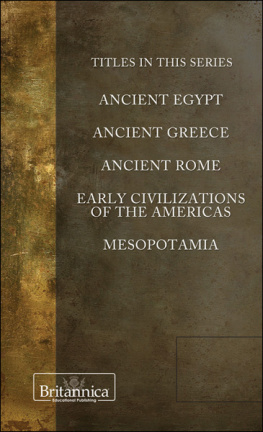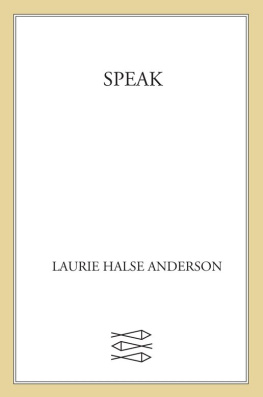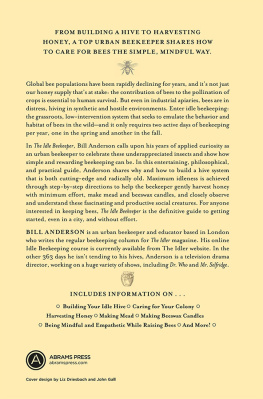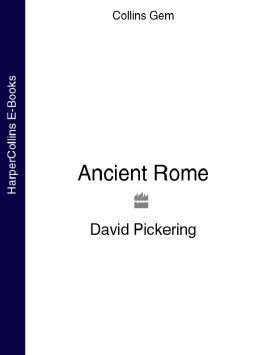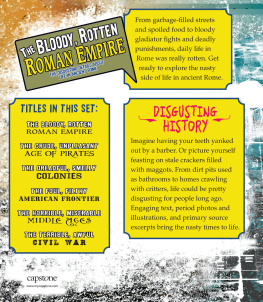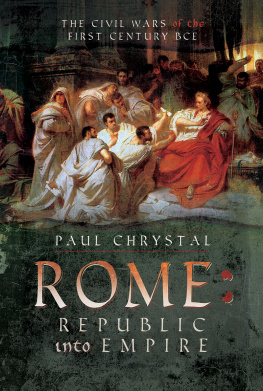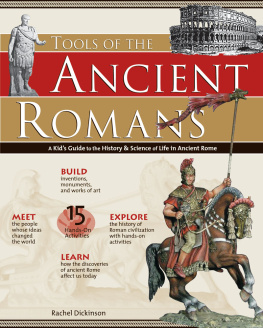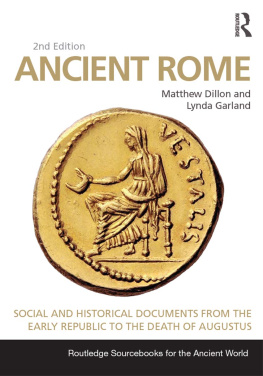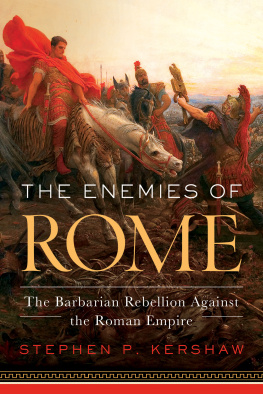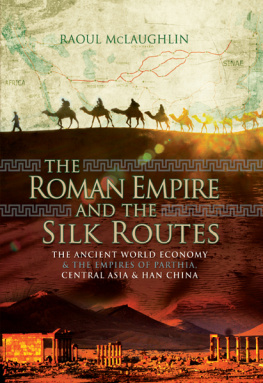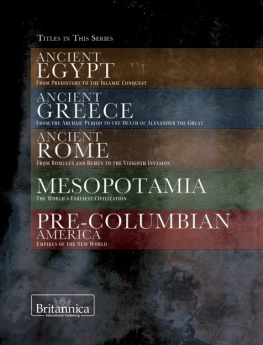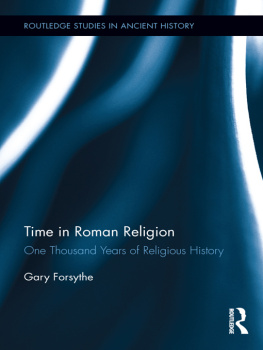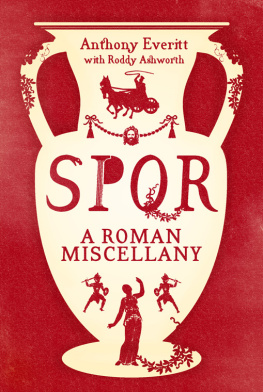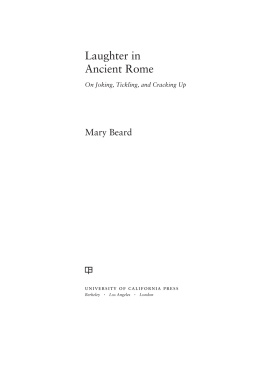ANCIENT
ROME
ANCIENT CIVILIZATIONS
ANCIENT
ROME
Edited by Michael Anderson

Published in 2012 by Britannica Educational Publishing
(a trademark of Encyclopdia Britannica, Inc.)
in association with Rosen Educational Services, LLC
29 East 21st Street, New York, NY 10010.
Copyright 2012 Encyclopdia Britannica, Inc. Britannica, Encyclopdia Britannica, and the Thistle logo are registered trademarks of Encyclopdia Britannica, Inc. All rights reserved.
Rosen Educational Services materials copyright 2012 Rosen Educational Services, LLC.
All rights reserved.
Distributed exclusively by Rosen Educational Services.
For a listing of additional Britannica Educational Publishing titles, call toll free (800) 237-9932.
First Edition
Britannica Educational Publishing
Michael I. Levy: Executive Editor, Encyclopdia Britannica
J.E. Luebering: Director, Core Reference Group, Encyclopdia Britannica
Adam Augustyn: Assistant Manager, Encyclopdia Britannica
Anthony L. Green: Editor, Comptons by Britannica
Michael Anderson: Senior Editor, Comptons by Britannica
Sherman Hollar: Associate Editor, Comptons by Britannica
Marilyn L. Barton: Senior Coordinator, Production Control
Steven Bosco: Director, Editorial Technologies
Lisa S. Braucher: Senior Producer and Data Editor
Yvette Charboneau: Senior Copy Editor
Kathy Nakamura: Manager, Media Acquisition
Rosen Educational Services
Heather M. Moore Niver: Editor
Nelson S: Art Director
Cindy Reiman: Photography Manager
Karen Huang: Photo Researcher
Matthew Cauli: Designer, Cover Design
Introduction by Heather M. Moore Niver
Library of Congress Cataloging-in-Publication Data
Ancient Rome / edited by Michael Anderson.1st ed.
p. cm.(Ancient civilizations)
In association with Britannica Educational Publishing, Rosen Educational Services.
Includes bibliographical references and index.
ISBN 978-1-61530-571-1 (eBook)
1. RomeCivilization-Juvenile literature. 2. RomeHistoryJuvenile literature. I. Anderson,
Michael, 1972
DG77.A583 2012
937dc22
2011004749
On the cover, page : The Colosseum in Rome, Italy. Shutterstock.com
Pages www.istockphoto.com/WillSelarep; remaining interior background image www.istockphoto.com/AndrewMasters; back cover Shutterstock.com
CONTENTS





INTRODUCTION
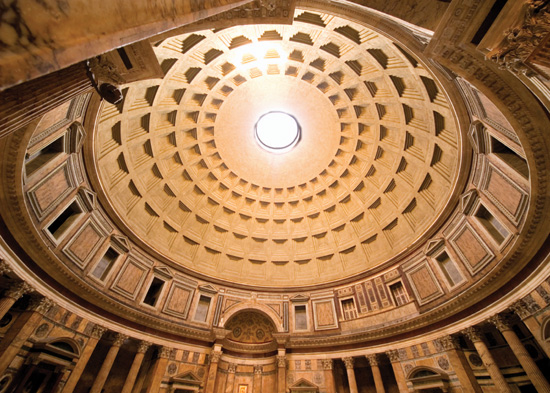
J ulius Caesars triumphant quote, Veni, vidi, vici (I came, I saw, I conquered), could be ancient Romes rallying cry. The Romans excelled in warfare, engineering, and government, a trio of strengths that helped them become a world power. During the period of the Roman Empire, most of the known world was united under Roman rule. This volume provides a lively overview of the history of ancient Rome and highlights its many literary, architectural, and engineering achievements as well.
Romes early history is shrouded in myth and legend. According to tradition, the city was founded by twin brothers, Romulus and Remus, in 753 BC, and Romulus served as Romes first king. Although Romulus was a mythical figure, the kings who followed him likely existed. The last three kings of Rome were Etruscans who ruled in the 6th century BC. These kings made improvements to the city, building temples and public works such as the remarkable sewer Cloaca Maxima. Rome prospered and became Italys wealthiest city.
Still, Etruscan rule was not universally appreciated. Around 509 BC the Romans revolted against the tyrannical king Tarquinius Superbus and expelled the Etruscans from the city, making Rome a republic. Initially the aristocracy, called patricians, ran the government, while the common people, or plebeians, had little to do with it. After a long struggle, however, it was declared in 367 BC that one of Romes two leaders, or consuls, must be a plebeian. By 350 BC plebeians were included in the dictatorship. With this rise came inclusion in the Senate. In addition, a new assembly, the comitia tributa, now had some sway. In this body, one mans vote was equal to all others.
Meanwhile, Rome used its military might to conquer its neighbors. In the 4th century BC the Romans battled the Etruscans, the Latins, and the intimidating Samnites. With the final defeat of the Samnites in 295 BC, Rome ruled northern and central Italy. The ensuing conquest of the Greek city-states that occupied the south made Rome the master of all Italy. Rome skillfully united the conquered peoples. They were granted the status of allies and enjoyed self-rule and various degrees of Roman citizenship.

Romes Pantheon was built as a temple to the gods by Emperor Hadrian. Shutterstock.com
The Mediterranean was Romes next target. Beginning in 264 BC, Rome fought three wars against the Carthaginians: the Punic Wars. Rome triumphed every time and finally ruled the Mediterranean Sea. Unfortunately, the young rulers of the time did not share the sage polices of the rulers before them, causing them to ruin the very countries they struggled to win.
The murder of the politician Tiberius in 133 BC triggered a century of political strife and civil war. During this time Pompey and Julius Caesar emerged as great leaders. Caesar became so powerful that 60 senators assassinated him in 44 BC. Caesars soldiers then united behind his adopted son Octavian, who became a potent leader in his own right.
Octavian presented Rome as a republic, but most historians agree that by 31 BC the Roman Empire had commenced. More than 200 years of relative peace and prosperity followed. Free men throughout the Empire were considered Roman citizens, and Roman law was applied in every court. Christianity slowly spread and became the Empires official faith. At the end of this period, a line of five great emperors brought Rome to new heights. One of them, Hadrian, fortified the Empires frontiers with a wall that still stands in parts of Britain. After the death of Marcus Aurelius in AD 180, however, a succession of short-lived emperors and Constantines transfer of the capital to the east irreparably divided Rome. The barbarian uprisings that ensued finally toppled the Empire.
Rome was far more than imperial superiority. Trading cities were bigger than ever and featured theaters, huge arenas, and public baths. In engineering the Romans could boast an impressive road system and bridges. The Latin language is lauded for its beauty in all types of literature. Roman authors such as Virgil and Cicero are still studied today.
Ancient Rome is a fascinating study of battle and government, of engineering and art. This volume offers an intriguing look at Romes many accomplishments, highlighting the many layers of this fertile culture.
Next page
